Posted by Elena del Valle on February 8, 2008
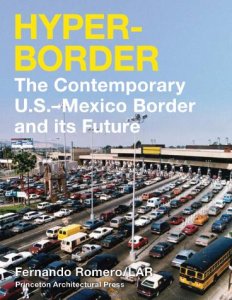
Hyperborder The Contemporary U.S.-Mexico Border and its Future cover
Photos: Alfonso Caraveo, Colegio de la Frontera Norte, LAR/Fernando Romero
The Mexico-United States border, with one million daily crossings, is one of the busiest borders in the world. The ninth longest in the world and the fourth longest in the Americas, it has an area bigger than some countries like Spain or Sweden and a population greater than Portugal or Guatemala.
Mexico City resident and architect Fernando Romero, with the help of nine project staff including two designers, interviewed academics, researchers and organizational representatives in North America to write about the United States-Mexico border from multiple points of view reflective of varied disciplines. In his recently published 317-page paperback book, Hyperborder The Contemporary U.S.-Mexico Border and its Future (Princeton Architectural Press, $35) he dedicated 15 chapters to the topic.
Target Latinos effectively by anticipating changes in the market with
“Hispanic Projections with 2007-08 update” audio recording

Presenter Roger Selbert, Ph.D.
Find out
- About Latino buying power growth in the future
- How Latino market growth compares with other markets in the U.S.
- What drives the rise of Latino economic clout
- Who should target the Latino market
- What is the size of the Hispanic affluent market
- If the luxury Latino market is growing
Stay ahead of your competition with “Hispanic Projections”
In the book, he describes the U.S.-Mexico border as “among the most contrasting borders in the world” and “a dynamic site that encompasses modern global issues.” He uses the term hyperborder to describe a geographical and political boundary as well as a demarcation line for culture and economic conditions.
Romero’s book is peppered liberally with black and white photos, maps, graphs, charts and bright orange accents to highlight and emphasize content. He starts from far away; looking at borders in other parts of the world to provide a comparative understanding of what makes the United States-Mexico border special. He dedicates several chapters to border data, reactions to the border and the relationship between the two neighboring countries and its significance.

Fernando Romero, author, Hyperborder
He examines 12 themes he believes will play a pivotal role in the future of the border and the two countries that share it. These are: security issues, drug traffic, informal sector, migration, education, trade and economic development, transportation, energy, environment, health and urbanization.
Mexico City born Romero is the founder of Laboratory of Architecture (LAR), a Mexico City-based architecture firm established to address society through a process of architectural translation and urban study.

Click here to buy Hyperborder
Comments:
Filed Under: Books
Posted by Elena del Valle on January 18, 2008
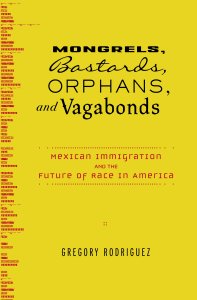
Mongrels, Bastards, Orphans & Vagabonds cover
Photo: John Nelson
Los Angeles syndicated op-ed columnist Gregory Rodriguez dedicated two years to researching and writing a book, the recently published Mongrels, Bastards, Orphans & Vagabonds: Mexican Immigration and the Future of Race in America (Pantheon Books, $26.95), to expose the relevance and influence of Mexicans in the United States. In the 336-page hardcover book on the legacy of Mexican-Americans, the largest Hispanic subgroup, he examines the influence and evolution of Mexicans in America from 1519 to the present.
In the heavily researched book (there are 39 pages of references at the back of the book), Rodriguez espouses a concept that is likely to make many conservatives cringe. He believes the Mexicanization of America will transform the U.S. into a mestizo culture and broaden the country’s belief in the melting pot.
Rodriguez follows the conquest of Mexico and the northward movement of the mestizo population to modern day America; he examines the rise of a new Mexican American identity in the 1930s in the wake of mass repatriations and deportations and offers a revisionist history of the Mexican presence in America’s Southwest. He describes the origins and culmination of the Chicano Movement, and looks at the importance of Mexican-American confidence and integration.

Gregory Rodriguez, author, Mongrels, Bastards, Orphans & Vagabonds
In the book, he focuses on a topic many have been discussing of late, the increasing racial and cultural blending nationwide. He explores the idea that America is changing. In the Preface he promises: “…Mexicans, who have always confounded the Anglo American racial system, will ultimately destroy it too.”
The book is divided into nine chapters: Birth of a People, The Rise and Fall of the Spanish Colonial Racial System, The Spaniards Venture North, Mexicans and the Limits of Slavery, The Anglos Move West, Caught Between North and South, Becoming Mexican American, The Chicano Movement and Mongrel America and the New Assimilation.
Rodriguez is a columnist for the Los Angeles Times and a former MSNBC political analyst. His work has been published in The New York Times, The Economist, The Washington Post, The Wall Street Journal, and Newsweek. He is the director of the California Fellows Program and a Senior Fellow at the New America Foundation, a non-partisan public policy institute.
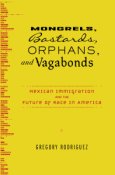
Click here to buy Mongrels, Bastards, Orphans, and Vagabonds
Target Latinos effectively by anticipating changes in the market with
“Hispanic Projections with 2007-08 update” audio recording

Presenter Roger Selbert, Ph.D.
Find out
- About Latino buying power growth in the future
- How Latino market growth compares with other markets in the U.S.
- What drives the rise of Latino economic clout
- Who should target the Latino market
- What is the size of the Hispanic affluent market
- If the luxury Latino market is growing
Stay ahead of your competion with “Hispanic Projections”
Comments:
Filed Under: Books
Posted by Elena del Valle on December 21, 2007

Click on image to enlarge
Photo: The Hispanic Center
The Hispanic Center, Inc./El Centro Hispano, Inc. published Pittsburgh’s first Spanish service directory. Sponsored by 84 Lumber and 28 other project supporters, the 302-page Directorio de Servicios Para la Comunidad Latina (Spanish Service Directory for the Latino Community) was launched with great fanfare at the Duquesne University Bayer Learning Center earlier this month.
Hispanics in the area, 11,000 in Allegheny County and 6,500 in greater Pittsburgh, according to Center representatives, will be able to find information in Spanish on services in their community in the new directory. The Hispanic Center printed 5,000 copies of the directory which is available free of charge to area residents who pick up a copy in person.
“The directory is pretty comprehensive; on top of that, it is a bold move to The Hispanic Center, considering the size of the Hispanic population in this area. We did the right thing (market leaders). But guess what? As it is happening all over the US, the Latino population here is the only one that presents a significant growth, while all other population types are either unaltered or has a negative growth,” said Pedro Paulo Bretz, executive director, The Hispanic Center, Inc.
Find out which Latino markets are booming with
“The Next Step: Secondary Latino Markets” audio recording

Presenter Dora O. Tovar, MPA
Click here for information on Secondary Latino Markets
There are three main target audience groups for the book. They are new Spanish speaking residents in the Pittsburgh region, human resource managers seeking a diverse workforce, and people who want to learn about the Hispanic community in Pittsburgh or who wish to learn Spanish as a second language.
The directory is divided into 20 sections that cover emergency assistance, identification, police, social services, culture, health, employment, education, religion, community organizations, legal services, Latino restaurants and stores, and professional services.
The mission of The Hispanic Center, a non profit organization, is to “Recruit, train, provide employment referrals services to, and retain individuals in Southwestern Pennsylvania (SWPA), by promoting skill enrichment, career opportunities and personal development of Hispanic individuals and their families.”
Hispanic Marketing and Public Relations Understanding and Targeting America’s Largest Minority book
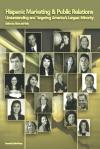
“A must resource for practitioners/professionals expecting to reach US Hispanics; also valuable for college programs in marketing, public relations and communications. Highly recommended.”
Choice magazine
Click here for information on the Hispanic Marketing & Public Relations books
Comments:
Filed Under: Books
Posted by Elena del Valle on December 10, 2007

Cristina Benitez, author, Latinization
Photo: Cristina Benitez
A podcast featuring an interview with Cristina Benitez, author, Latinization: How Latino Culture is Transforming the U.S., is available in the Podcast Section of Hispanic Marketing & Public Relations, HispanicMPR.com. During the podcast, she discusses her book with Elena del Valle, host of the HispanicMPR.com podcast.
Cristina is the founder of Lazos Latinos, a Chicago branding and advertising company specializing in Hispanic markets. Prior to founding her company in 1998, she was senior vice president, Ethnic Marketing, DraftWorldwide. Before that she was vice president at FOVA, Grey Advertising’s Hispanic marketing group. Her experience includes teaching secondary and college students Spanish for eight years. She is a board member of the Gateway Foundation, The Chicago Public Library, and The Hispanic Alliance for Career Enhancement and Luna Negra Dance.
In her recently released 128-page book, Latinization: How Latino Culture is Transforming the U.S. Cristina, a second generation Latina, relied on 20 years of Hispanic marketing experience and the input of 20 leaders.

Click here to purchase Latinization
In the book, she also included quotes and the insights of 14 men and six women in the arts and sciences, many from the Chicago area, in her efforts to define the influence of Hispanics on American culture. The leaders Cristina consulted include Hispanics and non Hispanics; entrepreneurs, authors, artists, performers, managers and the first woman to walk in space.
To listen to the interview, scroll down until you see the “Podcast” on the right hand side, then select “HMPR Cristina Benitez” click on the play button below or download it to your iPod or MP3 player to listen on the go, in your car or at home. To download it, click on the arrow of the recording you wish to copy and save to disk. The podcast will remain listed in the December 2007 section of the podcast archive.
Posted by Elena del Valle on October 26, 2007

Beyond Translation cover
Photo: Moving Target Research Group
In her soon to be released book, Beyond Translation The Marketer’s Field Guide to Understanding Today’s Transcultural Consumer, Valerie Romley, chief research officer of Moving Target Research Group, promises readers insights and strategy for marketers to connect with consumers of the top three emerging majorities in the United States, Hispanic, Pacific-Asian and Asian-Indian markets.
The 242-page book, published by Moving Target Press, will be available online and in print October 29, 2007. Marketing professionals are invited to download a copy free at the company website. The general public can purchase a paperback copy for $24.95.
According to promotional materials, it is designed as a guide for marketers seeking to understand who, what, how and why consumers respond to marketing strategies. The author focuses on insights on culture and context that simultaneously drive conflicting behavior and prevent effective communication across cultures. She dedicates about half of the book to Hispanic market issues.
“Asian-Americans, Hispanic-Americans, Asian-Indian Americans are blurring the traditional symbols of ethnicity based on race, language, country-of-origin and culture,” said Romley. “They are rapidly evolving and challenging the definition of ‘ethnic’ or ‘multicultural’ marketing. The book goes beyond the language of debate, beyond ‘in-culture marketing,’ beyond the repurposed marketing clichés and gives marketers the tools necessary to understand the drivers behind behavior, so that they can develop relevant and effective connections that resonate with the core of today’s transcultural consumer.”
“Best in Class Hispanic Strategies” audio recording


Presenters Carlos Santiago and Derene Allen
-
Find out what makes 25 percent of the top 500 Hispanic market advertisers out perform the remaining companies
-
Discover what questions to ask, steps to take to be a Best in Class company
Click here to buy “Best in Class Hispanic Strategies” audio recording
In the book, she also illustrates marketers’ most common key failures and their effects on communication breakdowns. The field guide offers seven steps to help readers crack the multicultural code and connect with transcultural consumers.
Romley, founder of Moving Target Research Group, specializes in general and transcultural markets with consumer research and fieldwork. She describes Experiential Research as proprietary methodology that combines the cultural intelligence, contextual research, influencer and experiential marketing to connect brands with their target markets. Moving Target Research Group is a global brand research consultancy.

Click here to purchase Beyond Translation; The Marketer’s Field Guide to Understanding Today’s Transcultural Consumer
Comments:
Filed Under: Books
Posted by Elena del Valle on October 5, 2007
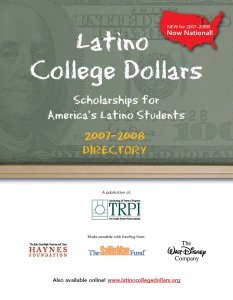
Latino College Dollars Scholarship Directory
Photo: Tomas Rivera Policy Institute
The Tomas Rivera Policy Institute (TRPI) recently expanded its Latino College Dollars Scholarship Directory, available online and in print, with national scholarship information for students. Response to the organization’s first Latino scholarship published last year prompted the Institute to produce a national guide in 2007. Last year’s directory of California scholarships was viewed online an average of 7,000 times a month.
The 2007 directory contains 84 pages of information including 62 pages on 329 scholarships available to Latino high school, undergraduate, and graduate students in the United States. The Directory can be downloaded free of charge at LatinoCollegeDollars.org. Hard copies of the guide are available for a postage and handling fee of $5.
The directory, made possible with grants from the John Randolph Haynes and Dora Haynes Foundation, The Sallie Mae Fund and The Walt Disney Company, follows recommendations from a TRPI study that showed Latino students often are misinformed or unaware of scholarship opportunities.
“Our research has shown that Latino families aspire to send their children to college but are critically lacking in awareness of how to pay for it. We’re working to be sure Hispanic parents and students are not caught in a financial aid information divide,” said Kathleen deLaski, president of The Sallie Mae Fund, which last year awarded $2.6 million in scholarships to more than 1,000 students nationwide. The directory is aligned with the charitable organization’s mission of increasing access to higher education for America’s students.
“Latino Family Dynamics” audio recording


Brenda Hurley and Liria Barbosa
Discuss
- Latino purchasing habits and products they favor
- Latino family characteristics
- Latinos and extended families
- Division of duties, responsibilities within the family
- Who is the decision maker in the Latino family
- Who is the information provider in the Latino family
Click here to find out about Latino purchasing habits and “Latino Family Dynamics”
Scholarship listings are categorized by education level, deadline, minimum grade point average, citizenship requirements and region. In addition to information on 329 scholarships, the 2007-2008 directory includes a guide to applying for scholarships, in English and Spanish, “Get the Money You Need!” and “Padres: ¡Ayuden a sus hijos a obtener el dinero que necesitan para asistir la universidad!“
“We can think of no better investment to make than in future talent,” said Efrain Garza Fuentes, director of Multicultural Programs for The Walt Disney Company. “The Latino college community is very important to The Walt Disney Company, and since we had such great success with the directory at the local level, the next logical step was a national effort.”
The online directory is searchable by grade level, grade point average (GPA) and citizenship requirements. Organizers hope the search functionality makes the online directory user-friendly.
According to a study conducted by the Institute and commissioned by The Sallie Mae Fund in 2006, the directory is a much needed resource for the Latino community. The study also found that often scholarship information is conflicting, out-of- date and not actively disseminated to people who need it. The study also indicated 94 percent of Latino parents believe college education is an important part of success in life, but more than half could not name a single source of financial aid.
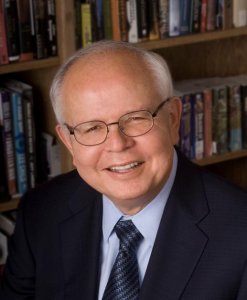
Harry Pachon, president and chief executive officer, Tomas Rivera Policy Institute
“This project has been very valuable to Latino students and their parents in California, and now the positive impact will be nationwide,” said Harry Pachon, president and chief executive officer of the Tomas Rivera Policy Institute. “We are very excited about encouraging the pursuit of a higher education, about giving Latino students the information they need to help start and finish college by making it more affordable. We expect demand this year to surpass the pace set last year.”
As part of the project the Institute will mail 6,000 scholarship guides to guidance counselors at low-income schools in the five states with the largest Latino populations in the country, California, Florida, Illinois, New York, and Texas. Another 2,500 scholarship guides will be distributed to Latino students during The Sallie Mae Fund Paying for College Bus Tour. An additional 1,500 guides will be distributed to community based and direct service organizations such as The Mexican American Legal Defense Fund, Parent Institute for Quality Education, and the Hispanic Scholarship Fund.
Founded in 1985, the Tomas Rivera Policy Institute (TRPI) advances informed policy on key issues affecting Latino communities through research contributing to the betterment of the nation. TRPI is an affiliated research unit of the University of Southern California School of Policy, Planning, and Development and is associated with the Institute for Social and Economic Research and Policy at Columbia University.
Comments:
Filed Under: Books
Posted by Elena del Valle on September 14, 2007

Thalia: Belleza! Lessons in Lipgloss and Happiness cover
Photo: Chronicle Books
Singer Thalia shares beauty tips in a new 208-page book, Thalia: Belleza! Lessons in Lipgloss and Happiness (Chronicle Books, $19.95) due out October 2007. Known for her singing, she’s had four top hits and sold over 12 million albums worldwide, the Mexican celebrity is recognized by telenovela fans in 180 countries. She has an ABC radio talk show and now counts publishing a book among her accomplishments.
Thalia: Belleza! Lessons in Lipgloss and Happiness, released in English and Spanish simultaneously, has illustrated chapters on skin, hair, makeup, and inner beauty. In the book, Thalia shares personal beauty secrets, beauty dos and don’ts, and beauty tips gleaned from working with top makeup artists and hairstylists. Color photos illustrate techniques and before-and-after features.
According to promotional materials, both books will be supported by a major national marketing campaign, with in-store appearances, podcasts, online promotions and a multi-tiered publicity campaign, including print, online, and national TV and radio.
Thalia began her career as a child star on Mexican television and theatre. A recording artist for EMI Music, she has been nominated for four Latin Grammy awards. She has had twelve Top 10 singles, four of which went to number one. Thalia received two Latin Billboard Awards and several Premio Juventud Awards. She has been named one of People Espanol Magazine’s “25 Most Beautiful” on two separate occasions.
In 2003, she launched the Thalia Sodi Collection line of apparel and accessories at Kmart. According to promotional materials, her Kenmark line of eyewear for women and girls topped $100 million in sales. She teamed up with Hershey’s to launch a line of co-branded candies, La Dulceria Thalia. This year, there are plans for an album release.
Founded in 1967, the Chronicle Books mission is to create and distribute exceptional publishing that’s instantly recognizable for its spirit, creativity, and value.
Click here to purchase Thalia: Belleza! Lessons in Lipgloss and Happiness
“Latino Family Dynamics” audio recording


Brenda Hurley and Liria Barbosa
Discuss
Latino purchasing habits and products they favor
Latino family characteristics
Latinos and extended families
Division of duties, responsibilities within the family
Who is the decision maker in the Latino family
Who is the information provider in the Latino family
Click here for more about “Latino Family Dynamics”
Comments:
Filed Under: Books
Posted by Elena del Valle on August 27, 2007

KR Jones, author, The Ghosts of Guantanamo Bay
Photo: KR Jones
A podcast interview with KR Jones, author, Ghosts of Guantanamo Bay, is available in the Podcast Section of Hispanic Marketing & Public Relations, HispanicMPR.com. During the podcast, KR discusses her fiction novel with Elena del Valle, host of the HispanicMPR.com podcast.
K.R. was born and raised on Long Island, New York, and called Northport her home. Creative at an early age, she acted in plays, sang in musicals, and even played the keyboard in an amateur rock band. She began her first novel when she was 14. Although she didn’t get beyond nine chapters, the project became a turning point in her life, helping her realize her true passion was telling stories.
Her years at Marymount College of Fordham University set the stage for the kinds of books she would later write. Her studies in political science and international relations included a year at Humboldt Universitat in East Berlin and the Universidad de Salamanca, Spain. Her adventures abroad made her long to bring what she learned and experienced to the pages of intriguing and suspenseful novels. She worked at the United Nations Social and Economic Council, and was a researcher for a major lobbying firm in Washington DC, where she learned about the political world.
Married to a Marine Corps officer, she spent the next several years at various duty stations around the country, before a final two-year tour of duty at U.S. Naval Base Guantanamo Bay, Cuba. It was this tour which inspired her to write her first novel, The Ghosts of Guantanamo Bay. Today she lives and writes in rural northern Virginia with her husband, and two children.
To listen to the interview, scroll down until you see “Podcast” on the right hand side, then select “HMPR KR Jones,” click on the play button below or download the MP3 file to your iPod or MP3 player to listen on the go, in your car or at home. To download it, click on the arrow of the recording you wish to copy and save to disk. The podcast will remain listed in the August 2007 section of the podcast archive.
Discover why so many readers are fascinated with KR Jones first novel, The Ghosts of Guantanamo Bay
Click the button to hear the podcast:
Posted by Elena del Valle on August 17, 2007
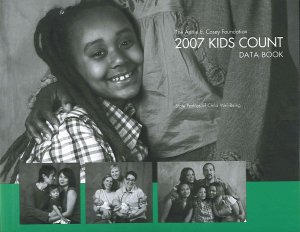
2007 Annie E. Casey Foundation Kids Count Data Book
Photo: Annie E. Casey Foundation
According to the recently released 2007 Annie E. Casey Foundation annual national Kids Count Data Book, Hispanic teens are the most likely to become pregnant and drop out of school. In 2005, Latino teenagers were more than twice as likely as non Hispanic whites to drop out. While 6 percent of non Hispanic whites between 16 and 19 dropped out, 14 percent of Latinos in the same age group left school.
In 2004, Latino girls 15 to 19 were more than three times as likely to become pregnant than non Hispanic white girls of the same age. The teen birth rate among Latinas was 83 for every 1,000 girls compared to 26 births for every 1,000 non Hispanic white girls.
The good news is that these indicators have been moving in the right direction for Hispanic teens. The Hispanic teen birth rate dropped 5 percent since 2000 and the Hispanic high school drop out rate dropped 31 percent since 2000.
“Unfortunately, the percent of Hispanic teens who are high school dropouts and the teen birth rate for Hispanic teens has consistently been the highest among the racial and ethnic groups we look at in our report over the last several years,” said Laura Beavers, research associate, Kids Count. “One exception was that in 2000, the high school dropout rate for American Indian teens was slightly higher than for Hispanic teens.”
This year, for the first time since 1990, the Annie E. Casey Foundation (AECF) annual national Kids Count Data Book includes data on children living in Puerto Rico in a separate section of the book. According to Foundation findings, children in Puerto Rico face higher levels of risk on nine of ten key indicators of child well-being.
Hear from market researchers about the Latino family in
“Latino Family Dynamics” audio recording


Brenda Hurley and Liria Barbosa
Click here to purchase “Latino Family Dynamics”
“The Kids Count Data Book is the gold standard for all those interested in data on the status of children in this country. The inclusion of Puerto Rico not only is a welcome and much-needed addition, but also will ensure that the urgent needs of Puerto Rico’s children are taken more fully into account,” stated Janet Murguía, president and chief executive officer, National Council of La Raza.
The National Council of La Raza has housed the Kids Count Puerto Rico Project for the last five years. The organization published several reports and provided free information through an online database.
According to the 192-page report, in 2005, there were one million children in Puerto Rico. This represents a larger child population than that of about half the states in the United States. Puerto Rico’s child poverty rate, 55 percent, was nearly three times that of the U.S.
The Annie E. Casey Foundation is a private charitable organization, dedicated to fostering public policies, human services reforms, and community supports to meet the needs of vulnerable children and families. The 2007 Kids Count Data Book is available online and can be ordered free of charge.
Comments:
Filed Under: Books
Posted by Elena del Valle on July 27, 2007
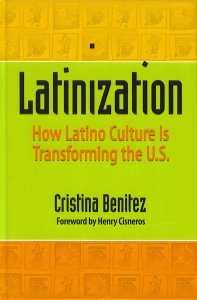
Latinization cover
First time author Cristina Benitez explores the positive impact of Latinos on mainstream America in her recently released 128-page book, Latinization: How Latino Culture is Transforming the U.S. (Paramount Market Publishing, $24.95). The second generation Latina relied on 20 years of Hispanic marketing experience and the input of 20 leaders.
In the book, she also included quotes and the insights of 14 men and six women in the arts and sciences, many from the Chicago area, in her efforts to define the influence of Hispanics on American culture. The leaders Benitez consulted include Hispanics and non Hispanics; entrepreneurs, authors, artists, performers, managers and the first woman to walk in space.
They are: Juan Andrade, Jr., president, United States Hispanic Leadership Institute; Rick Bayless, a Mexican cuisine expert; Aldo Castillo, an art dealer, artist and human rights activist; Henry Cisneros, founder and chairman, CityView; Mary A. Dempsey, commissioner, Chicago Public Library; Robert Fitzpatrick, Pritzker director and chief executive officer, The Museum of Contemporary Art; Henry Godinez, resident artistic associate, The Goodman Theatre; Juana Guzman, vice president, National Museum of Mexican Art; Carlos R. Hernandez, executive director, Puerto Rican Arts Alliance; Achy Obejas, author; Sylvia Puente, director, The Center for Metropolitan Chicago Initiatives of The Institute for Latino Studies, University of Notre Dame; Jorge Solis, director, Illinois Division of Banking; Kathryn Sullivan, president and chief executive officer, Center of Science & Industry; Andrés T. Tapia, chief diversity officer and emerging workforce solutions leader, Hewitt Associates; Studs Terkel, author; Carlos Tortolero, founder and president, National Museum of Mexican Art; José A. Vargas, founder and executive director, The International Latino Cultural Center; Eduardo Vilaro, founder and artistic director, Luna Negra Dance Theater; Father Bruce Wellems, pastor, Holy Cross/Immaculate Heart of Mary Parish.
Benitez is the founder of Lazos Latinos, a Chicago branding and advertising company specializing in Hispanic markets. Prior to founding her company in 1998, she was senior vice president, Ethnic Marketing, DraftWorldwide; before that she was vice president at FOVA, Grey Advertising’s Hispanic marketing group. Her experience includes teaching secondary and college students Spanish for eight years. She is a board member of the Gateway Foundation, The Chicago Public Library, and The Hispanic Alliance for Career Enhancement and Luna Negra Dance.

Click here to purchase Latinization
Comments:
Filed Under: Books



































